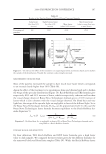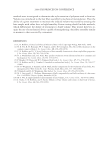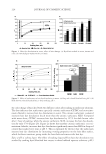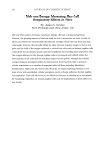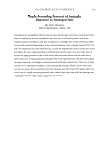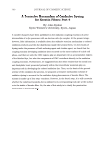2008 TRI/PRINCETON CONFERENCE 279 DISCUSSION AND CONCLUSIONS The ability of various oils to perform conditioning functions is related to their mo- lecular characteristics, such as surface energy, cohesive forces, and surface attaching conformation (7). All oils show good performance in reduction of split ends formation (%), combing resis- tance and gloss difference. For these analyses, the infl uence of the properties of the oils on fi lm formation are very important. The combing facility is the result of the decrease in friction on the hair surfaces. The degree of the triglycerides attachment to the hair surface is infl uenced by its molecular chain conformation and is responsible for the increase or decrease of frictional forces. The oils composed of triglycerides with linear chain, lower ramifi cation and higher number of carbons may increase the fi lm formation, which results in the best spreading. The triglyc- erides chains with more ramifi cations and high melting point may decrease the spreading by increasing frictional force, which explains the behavior of butters on the hair observed in this study. Preliminary studies showed that Buriti oil is very homogeneous in its fatty acid distribu- tion, 79% of oleic acid. This may result in a more smooth surface and, consequently, in a high specular light refl ection (gloss) from its surface. Ucuúba butter showed a slight increase in the stress to break. This butter has a high amount of low molar mass triglycerides composed of short and straight linear fatty acid chains (75% miristic acid (C14)). This may point to the conclusion that low molecules from vegetal origin are able to diffuse into hair fi ber. It is observed with coconut oil, which has lauric acid in its major composition (6). Mineral oil is known to give a conditioning effect to the hair but, since it has no affi nity to hair’s proteins, this oil is not able to diffuse in the fi ber. Mineral oil main effects are its higher spreading capability on the hair surface which improves gloss, combing facility and reduces split end formation. ACKNOWLEDGMENTS The authors would like to acknowledge Prof. Dr lnés Joekes, Dr. Atílio Cardoso and Dr. Nádia Segre from Instituto de Química–Universidade Estadual de Campinas–Brazil for the hair mechanical analysis. REFERENCES (1) A. S. Rele and R. B. Mohile, Effect of coconut oil on prevention of hair damage, Part I, J. Cosmet. Sci, 50, 327–339 (1999). (2) S. B. Ruetsch, Y. K. Kamath, A. S. Rele, and R. B. Mohil, Secondary ion mass spectrometric investiga- tion of penetration of coconut and mineral oils into human hair fi bers: Relevance to hair damage, J. Cosmet. Sci., 52, 169–181 (2001). (3) S. E. Kelly and V. N. E. Robinson, The effects of grooming in the hair cuticle, J. Soc. Cosmet. Chem., 33, 203–215 (1982). (4) C. R. Robbins, Chemical and Physical Behavior of Human Hair, 4th ed. (Springer-Verlag, New York, 2002), pp. 386–469. (5) R. Schueller and P. Romanowski, Conditioning Agents for Hair and Skin, Vol 21, 1999.
JOURNAL OF COSMETIC SCIENCE 280 (6) A. S. Rele and R. B. Mohile, Effect of mineral oil, sunfl ower oil, and coconut oil on prevention of hair damage, J. Cosmet. Sci., 54, 175–192 (2003). (7) J. Jachowicz, “Evaluating Effects of Conditioning Formulations on Hair,” in Conditioning Agents for Hair and Skin, 1st ed., R. Schueller and P. Romanowski Eds. (Marcel Dekker, New York, 1999), vol 21, pp. 301–336.
Purchased for the exclusive use of nofirst nolast (unknown) From: SCC Media Library & Resource Center (library.scconline.org)














































































